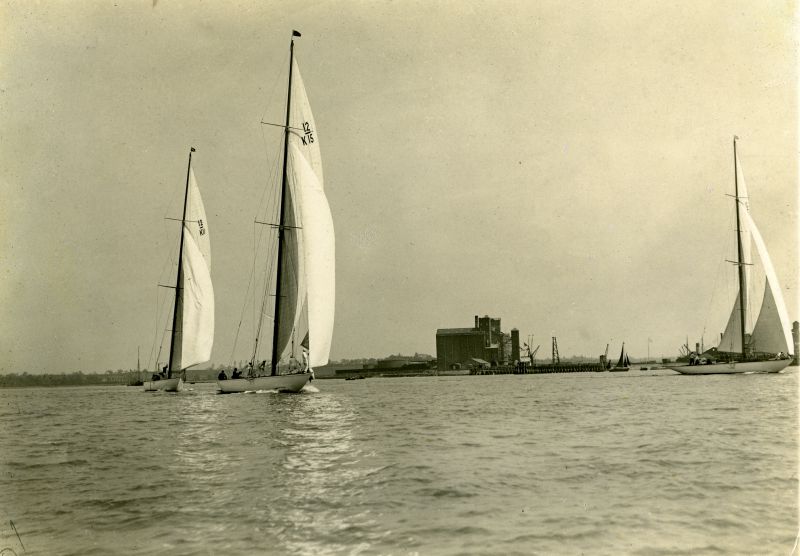12 metres stand out from Harwich harbour, past the grain mills of Felixstowe Dock. This photograph was taken at the Royal Harwich Yacht Club Regatta of either 1928, 1929 or 1930. K.15, in the foreground, is Thomas Sopwith's MOUETTE, then the most successful 12 metre, sailed by her owner and manned by Captain George Williams of Hamble, Hampshire, with a white clad, Solent crew. MOUETTE was designed and built by Camper and Nicholsons Ltd., Gosport, and was a success from her first season. Astern is Sir William Burton's IYRUNA, built in 1927 as the first of four of these yachts owned by this noted yachtsman, whose crews were from the Colne. Here IYRUNA is probably skippered by Captain James Barnard of Rowhedge, with three hands from the village.
Rig has changed from the cutters of plate nnn to sloop, with a more efficient single large headsail, bringing the need for 'sheet capstans' (winches as we now call them) though some crews continued to use sheet tackles for a while, as they did in the larger racing yachts, where perhaps fifteen or more men could tail on to the fall to provide hauling power denied the professional crew of four handling a 12 metres 1900 square feet of foresail and mainsail, and twice that area with spinnaker set. Even then, the yachts had reached the finality in height of rig and ghe glued spruce masts required two pairs of wide spreaders and one set of small lower ones to maintain straightness, besides angled supporting struts and mid-height, for the backstay opposing the foresail halyard block. The 12 metre at the right has yet another set of small spreaders midway between the main upper and lower pairs.
On all three the shrouds are led to deck outriggers at the sheer, then still termed 'channels', to provide a broader base for staying.
The then modest commerce of Felixstowe dock shows in the pair of spritsail barges discharging grain and a solitary steam coaster, probably with coal; the traffic and atmosphere of this basin which persisted into the mid --- 1950s, after which the Dock Company were suddenly able to enlarge their activities with the closure of the adjacent Royal Air Force coastal aircraft base, which was developed for North Sea road/sea transport and container ships. Within ten years the Felixstowe Dock was the fastest growing port in Britain and is now the busiest. [JL]
IYRUNA is K11, MOUETTE is K15.
Plate.23 in SWW.
Used in The Sailor's Coast, page 57.
Date: c1929






